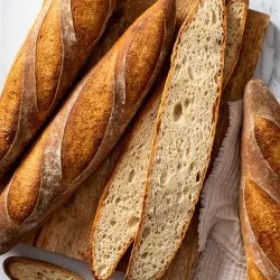
The Best Gluten Free Baguettes
Servings 3 baguettes
1 hr
Bread Gluten Free
Submitted by Brynne Corcoran
Ingredients
- 25 g (5 tbsp) whole/rough psyllium husk (If using psyllium husk powder, use only 21g.)
- 480 g (2 cups) lukewarm water
- 180 g (1½ cups + 1 tbsp) tapioca starch (You can use an equal weight of arrowroot starch, cornstarch (US)/cornflour (UK) or potato starch instead.)
- 180 g (1⅓ cups) millet flour, plus extra for flouring the surface (You can use an equal weight of finely milled/ground brown rice flour instead.)
- 60 g (⅓ cup + 2 tbsp) sorghum flour (You can use an equal weight of light buckwheat flour, white teff flour or oat flour instead. Use the latter only if you're not sensitive to oats.)
- 25 g (2 tbsp) caster/superfine or granulated sugar
- 10 g (2 tsp) salt
- 6 g (2 tsp) instant yeast (If using active dry yeast, use 8g.)
- 20 g (1½ tbsp) olive oil
- 10 g (2 tsp) apple cider vinegar
Directions
Making the dough:
You can prepare the dough using a stand mixer fitted with the dough hook attachment or by hand.
Make the psyllium gel: In a bowl, mix together the psyllium husk and warm water. After about 30-45 seconds, a gel will form.
In a large bowl or the bowl of a stand mixer (if using), whisk together the tapioca starch, millet flour, sorghum flour, sugar, salt and instant yeast.
Tip: If using active dry yeast instead, you need to activate it first. Mix it together with 120g (½ cup) of the water and half of the sugar listed in the recipe. Set aside for 5-10 minutes, or until the mixture starts frothing. Then, add it to the dry ingredients along with the psyllium gel, olive oil and vinegar.
Make a well in the middle of the dry ingredients and add the psyllium gel, olive oil and vinegar.
Knead the dough until it's smooth and all the ingredients are evenly incorporated. Use a rubber spatula to occasionally scrape along the sides and bottom of the bowl to prevent any dry patches of unmixed flour.
The final dough should come away from the sides of the bowl. It will be fairly soft but it shouldn’t be too sticky to the touch (note that this refers to when you gently touch it with clean hands – it will stick to your hands as you’re kneading it). Resist the temptation to add more flour to the dough, as that can make your baguettes dense and dry.
Turn out the dough onto a lightly floured work surface and divide into three equal portions, each should weigh about 330g.
Give each portion of dough a gentle knead to ensure that they're perfectly smooth.
Shaping the baguettes:
When you shape the baguettes, work on a lightly floured surface (you really want just a sprinkling of flour on your work surface). See the blog post for detailed step-by-step photos of the shaping process.
Take a piece of dough and pat it down into a rough rectangle, about ½-¾ inch (1.5-2cm) thick. I usually pat it down to a size of about 6x4½ inches (15x12cm) but don’t worry about the exact dimensions, they’re not really important.
Working along the wider end, fold the dough over itself and press down gently to seal. Continue folding the dough over itself (and pressing down to seal) so that you’re essentially rolling it up into a log.
Pinch the seam together to seal it. Don’t worry if your dough isn’t perfectly smooth at this point, it will smooth out even further when roll it into the typical baguette shape in the next step.
Use the palms of your hands to roll the dough back and forth until you reach the desired length – aim for a length of about 13-15 inches (33-38cm). While you’re rolling it, make sure that you also create the tapered shape: you want the baguette to be thicker in the middle and gradually taper to the ends. You can shape your baguettes with rounded or sharp, pointy ends, whichever option you like best.
Repeat with the other two portions of dough.
Proofing the baguettes:
Lightly flour the baguettes on all sides to ensure that they don't stick to the proofing couche or kitchen towel that you'll use to proof them.
Place the baguettes, seam-side up, into the folds of a floured baguette proofing couche or large kitchen towel. Cover them lightly with plastic wrap/cling film to prevent them from drying out.
Oven setup & pre-heating the oven:
Place a baking steel or a large baking sheet, turned upside-down, on the middle oven rack and a baking tray (not glass!) on the lower oven rack.
Tip 1: If you don't have a baking steel, make sure to use a sturdy, heavy duty baking sheet that's good at holding onto heat.
Tip 2: Because you'll add ice cubes to the hot baking tray on the bottom of your oven to generate steam, it will experience quite a huge temperature change. So, don't use a glass baking tray/pan as it could shatter. I recommend cast iron, but a metal baking tray also works great.
Preheat your oven for at least 45 minutes at 480ºF (250ºC). You want your oven, baking steel (or baking sheet) and baking tray thoroughly preheated before you put in the baguettes – this ensures maximum oven spring and therefore the prettiest (and most delicious) baguettes.
In practice, I usually turn on the oven as soon as I’ve arranged the baguettes in the couche/kitchen towel and let them to proof.
Scoring the baguettes:
Place a large sheet of parchment/baking paper on top of either a large pizza peel or a large baking sheet with no rimmed edges (you'll use this to slide the baguettes along with the parchment/baking paper onto the hot baking steel/baking sheet).
Once your baguettes have doubled in size, transfer them to the parchment/baking paper. Place them seam-side down and space them out as much as possible, so that they’ll have plenty of space around them during baking.
To transfer the baguettes from the couche or kitchen towel, you can use a baguette transfer board (transfer peel) or simply pick them up VERY GENTLY with your hands – be careful not to deflate them.
Use a bread lame or a sharp knife (held at about a 45º angle) to score each baguette with 3-4 lengthways slashes.
Baking the baguettes:
Slide the baguettes, along with the parchment/baking paper, onto the hot baking steel or baking sheet. Place 4-5 ice cubes into the bottom baking tray and immediately close the oven door.
Bake the baguettes at 480ºF (250ºC) with steam for 10 minutes. Don’t open the oven door during that time.
After the 10 minutes, open the oven door to let out the steam and remove the bottom baking tray. Close the oven, reduce the oven temperature to 425ºF (220ºC) and bake for 15-20 minutes longer or until the baguettes are deep golden-brown.
Remove them from the oven and cool on a wire rack until they’re *at least* lukewarm before you cut into them.
Storage:
These gluten free baguettes are at their very best on the day of baking. However, they keep really well for up to 3 days in a bread box, paper bag or wrapped in a clean kitchen towel. I recommend toasting them on day 3.
Notes
My neighbor made these and it absolutely blew my mind! Can't recommend this recipe enough. Enjoy!
Tip: While you're working with one piece of dough, keep the other two covered with a damp kitchen towel or plastic wrap/cling film to prevent them from drying out.
Tip: Proofing the baguettes between the folds of a proofing couche or kitchen towel helps to maintain their shape and prevents them from spreading out as they’re proofing.
Proof the baguettes in a warm spot for about 45 minutes to 1 hour or until they’ve doubled in size.
Tip: I know that it’s super tempting to eat them while they’re still hot, but the crumb needs time to cool down and fully set. If you cut them while they’re still hot or too warm, you’ll find the crumb quite sticky.
Tip: As they stand, their crust will lose its crispness and it will become softer. They will still be delicious, but their texture will inevitably change.
